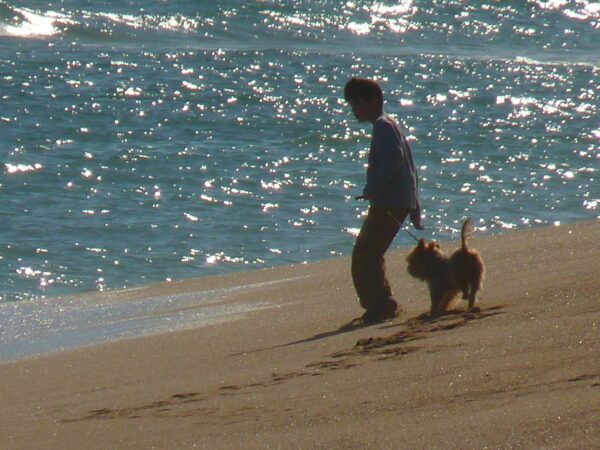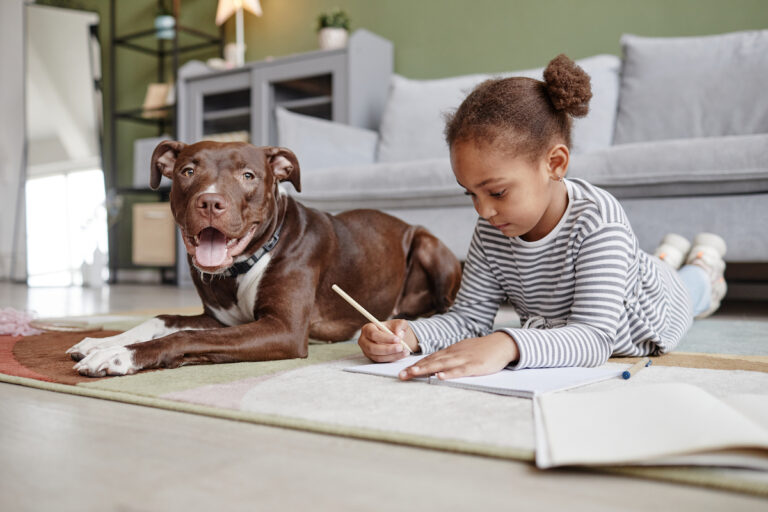Whether you have a dog that’s aggressive towards children or just want to keep your kids safe around dogs in general, there’s a lot you can do to keep kids safe around dogs. As a dog trainer and dog behavior consultant who specializes in dogs “with issues,” I see far too many cases of dogs and kids not mixing well.
While there are certainly plenty of training options available to help make a dog safer for kids, your best bet as a parent is to teach your kids how to be safe around dogs. Let’s look at some of my favorite, easy options to keep kids safe around dogs.
1. Teach Kids How to Interact With Dogs
For dogs on the street: Don’t let your children be “magnetized” to dogs. Teach your children to ignore dogs politely when the dogs are busy or walking. This is especially important when dogs are sleeping or being actively trained.
Two questions to ask the owner: Teach your children to ask the owner before reaching out. It’s all too common to see kids reaching for dogs to pet while they ask if it’s ok! Once the owner says it’s ok to pet, the child should next ask: “Where does [dog] like to be petted?” This allows the owner to tell your child exactly where the dog likes to be petted best!
For dogs your child can interact with (on the street or in a home): Teach your kids the pet-pet pause method. They can pet the dog for a few seconds (3-5 is best), then pause. See what the dog does. If the dog stays close or moves closer, your child can keep petting. If the dog moves away, great! We know the dog was all done.
Teach the kids basic dog manners: Many dogs (my own dog included) don’t appreciate when people lean over them or shove their faces in their faces. Most dogs like a bit of personal space from strangers! Teach your child to use her hands rather than her face to get to know a dog.
If a dog seems shy or apprehensive at all, steer your child to a different activity. Better safe than sorry!

2.Teach Kids about Dog Body Language.
Dog body language is pretty easy to read, especially if kids learn young. I always print out a copy of some Dog Decoder posters and hang it on the fridge when working with clients who have kids. You can also download the app, which has quiz features to teach kids how to read dog body language.
Signs of a friendly dog: Look for a loose, full-body tail wag. The dog’s whole butt should be wiggling. The dog’s eyes will often look “soft” or even slightly squinted. The dog should be looking at your child, but not staring.
Signs of an unsure dog: Low tail wags, especially if they’re fast or between the legs, indicate a scared dog. Avoid petting dogs where you can see the whites of their eyes or their mouths are closed tight. Dogs that avert their gaze or pull their ears far back should be left alone.
Signs of an aggressive dog: Stay far away from dogs that have a high, stiff tail wag (curling over their back), with forward posture and slow breathing. It should be obvious, but don’t bother dogs that are barking at your child. Dogs that are staring at your child should be avoided as well.
There are some great resources available at stopthe77.com as well – check them out!
3. Supervise, Supervise, Supervise.
If you’ve got a dog in your home, the best thing you can do is be the playground monitor. Watch your child and your dog like a hawk. Ensure that your child doesn’t pull on the dog’s fur, step on the dog, climb on the dog, or take the dog’s stuff (toys or food). Keep an eye on your dog’s body language. Even with the best education on body language, your child is still a child.
Of course, the older your kid gets, the more you probably can trust him around your dog. You might be able to leave an 8-year-old unattended with a dog – but I wouldn’t leave most 5-year-olds (or 2-year-olds) alone with a dog, no matter how well they seem to get along.
You are your child’s best bet of having good experiences with dogs. Ask your child to settle down or remove your dog if he gets too excited. Allowing small children and dogs to roughhouse is generally (but not always) a bad idea.
3. When You Can’t Supervise, Separate.
If you can’t keep an eye on your child and your dog, keep them separate. This means that when you’re cooking dinner or reading a book, the dog and child should be separated. It’s just too hard for most well-meaning parents to keep track of a dog, a child, AND an activity!
You can put your child in a playpen, put the dog in an exercise pen with some puzzle toys, put the dog in another room, ask your partner to take the dog or the child, or just occupy both the dog and the child with other activities.
The level of separation needed will vary based on the age of your child and the tolerance of your dog. When your child and your dog are old enough, coloring books and stuffed Kongs should be enough!
4. Teach Dogs to Say No, Thank You.
One of the most powerful ways to keep kids safe around dogs is to teach dogs to be comfortable around kids. When my dog Barley is around children, I watch him like a hawk. If he turns and moves away from the kids, I praise and reward him with a treat. That’s right – I reward him for choosing not to interact with the kids!
This teaches your dog that it’s ok to “turn down” an interaction. His polite “no, thank you” (turning or moving away from kids) is one of the best safety measures I have. When paired with kids who respect the boundaries of dogs, this is potentially lifesaving. I would much rather have a dog that chooses to walk away from kids than a dog who “puts up with it” until he snaps.
You can use the pet-pet pause method to teach your dog that he has control over how much people pet him. Teaching your dog if you walk away, we’ll leave you alone is a great, polite skill for all dogs to have.
5. Don’t Over-Rely on Treats
Too many well-meaning parents try to lure dogs in to say hi using treats. Some dogs will come close for the treats, take them gently, and then get scared! Let the dog choose to say hi to your child on his own, free of bribery. You can absolutely reward polite behavior with treats (treats after friendly behavior), but don’t use treats as a way to lure the dog in (treats to cause the dog to approach). See the difference?

6. Encourage on Age-Appropriate Interactions
Your two-year-old child should not be walking the family Golden Retriever, and the six-year-old probably can’t play tug-o-war with your Great Dane. Most small kids shouldn’t play rough-and-tumble or chase games with dogs. However, your six-year-old can probably help with feeding and brushing. Your two-year-old is at a good age to learn how to pet the dog and maybe toss a toy if your dog is extremely gentle.
Encourage your child and your dog to interact in ways that make sense for their size differences and maturity. You know your child and dog best, and this will be different for every family. In general, don’t let your child or dog do something if you wouldn’t bet $50 that your child and dog will BOTH be 100% gentle with each other!
How do you keep kids safe around dogs? What skills (for your child or for your dog) did I miss? I’d love to hear your ideas!


Thank you so much for this information. We had a scary interaction with a friend’s dog and our toddler. No harm was done to our toddler but if the owner and I hadn’t intervened, it would have been quite bad. Basically the dog stared down our toddler with a low growl and started moving towards him. Our toddler was 1m away looking back at the dog perplexed, but that seemed enough to annoy the dog. It still gives me shivers down my spine. I think my fears came from a lack of knowledge of how to prevent the situation and ultimately feeling powerless. I’m grateful for your article and that we were lucky enough to have had a warning scene. Will definitely start teaching toddler more about behaviour around dogs and also manage the situation better with interactions at our friend’s house. Our dog and toddler have such a beautiful bond that we’ve foolishly taken it for granted. Thank you ??
I’m glad you found this article helpful! Best of luck.
I absolutely loved this. My fur baby is well-behaved with the exception of little to no tolerance for young children. It’s almost as if he can recognize the difference between a 7 yr old and a 13 yr old from a mile away. I’ve had him since he was 3 months and he’s almost 2 yrs old, yet he was primarily raised around adults. As he’s gotten older he’s just switched to “stay away or I’ll protect myself”. I honestly don’t understand because he’s great in all other areas. I will try new approaches to help him be less reactive.
I really hope it helps! Best of luck.